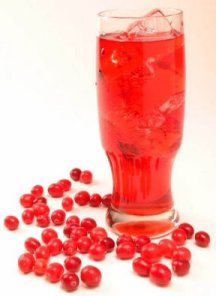Cranberry Juice—A Cocktail for the Heart
Chemist Joe Vinson has a passion for foods and the potentially beneficial antioxidants they bring to the dinner table.

Three years ago, for instance, he reported data showing that molecule for molecule, the antioxidants in chocolate exceed the potency of vitamin C. Now he finds another powerful stash of these protective compounds in cranberries and their juice. Moreover, the University of Scranton scientist reports this week at the American Chemical Society’s spring meeting in New Orleans, regular consumption of that juice yields cholesterol benefits in middle-age men and women.
Many plant-based foods, especially the colorful ones, contain large quantities of polyphenols. As antioxidants, these compounds quash the damage that natural oxidants can do in the body. Indeed, a large number of disorders associated with aging–including cancer, heart disease, diabetes, and several types of dementia–have been linked to damage caused by a slow and unremitting onslaught of oxidants.
In his latest study, Vinson and his colleagues provided 20 men and women 8-ounce servings of cranberry juice cocktail, which contains 27 percent juice. He offered his recruits the type available in stores, which is heavily sweetened with high-fructose corn syrup and supplemented with extra vitamin C, or a low-calorie alternative that the Scranton scientists concocted daily from pure juice. Twelve chose the low-cal juice, which was sweetened solely with a sugar-free compound.
Drinking cranberry juice three times a day over the course of a month increased all the volunteers’ blood concentration of high-density lipoprotein (HDL) cholesterol–the so-called good cholesterol–by 10 percent. The juice didn’t affect low-density lipoprotein (LDL) or triglycerides, which are other fatty substances in the blood. However, epidemiological studies by others have correlated HDL-cholesterol increases of this magnitude with about a 40 percent drop in heart-disease risk, Vinson notes.
Cranberries lead the antioxidant pack
In earlier studies, the Scranton team surveyed the antioxidant potential of several fruits and vegetables. Overall, fruits surpassed the veggies, “and cranberries had more antioxidants than any other fruit,” Vinson observes. Several of cranberry’s polyphenol antioxidants are procyanidins, the same family of pigments that make cherries red.
When the chemists investigated pure cranberry juice, they found its antioxidant punch exceeded by 50 percent the potency of its next closest juice competitor, grape juice. However, because cranberries are so tart, their juice has to be diluted and sweetened to be palatable. Yet even in this cocktail form, Vinson found, 27 percent cranberry juice still ranked second only to pure grape juice in its ability to defuse oxidants.
With funding and cranberries supplied by the Cranberry Institute, he then investigated antioxidants delivered to the blood by juice.
To evaluate whether it was the cranberry juice or the sugar and vitamin C in the cocktail that provided any benefit in the new study, the Scranton chemists offered just an 8-ounce glass of the sugar water and the vitamin to 10 men and women as a breakfast drink. Each had fasted the night before.
Over the next 4 hours, the researchers periodically sampled the volunteers’ blood and tested its ability to quash oxidants. To Vinson’s surprise, the blood actually fostered oxidation. After a bagel and soft drink at lunchtime, the assays continued and showed that the potentially unhealthy pro-oxidant effect lasted a total of 7 hours, Vinson told Science News Online.
On another day, he repeated the tests, this time giving each volunteer an 8-ounce glass of the sugar-sweetened cranberry juice cocktail. This time, he notes, “we had a good antioxidant effect for the whole 7 hours, even after that blast of high-fructose corn syrup [in the soft drink] and bagel at lunch.”
More juice, better protection
In a follow-up trial, Vinson’s team put 20 adults, mostly middle age and all with moderately elevated, unhealthy total-blood-cholesterol concentrations, on a cranberry-juice regimen. For the first month, each person drank a daily 8-ounce glass of either the sugared or surgarfree cranberry-juice cocktail. During the second month, each recruit drank two glasses daily. During the last month of the experiment, daily juice intake increased to three glasses.
Before the trial and at the end of each month, the scientists ran a series of tests on the blood of each participant. Those data confirmed that the antioxidant defense of the blood increased steadily with the increasing juice intake. Compared with the before-juice measurements, concentrations of oxidation products in the volunteers’ blood was 15 percent lower after the first month of the trial and about 40 percent lower by the close of the third month.
Assays of the participants’ blood showed no change in their triglycerides or total cholesterol concentrations. However, HDL cholesterol increased–but only in the three-glass-per-day phase of the trial. Just that’s worth a lot, says Vinson. Doctors lament the fact that although low-HDL cholesterol is a major risk factor for heart disease, there are few prescriptions they can offer patients that raise this lipid–other than to give up smoking, drink a little alcohol, or exercise regularly.
For people who would prefer a pocket version of the potential cranberry therapy for cholesterol, Vinson notes that dried berries are available in stores. His assays, by the way, indicate that dried cranberries pack 10 percent more antioxidants than prunes and 50 percent more than raisins do.







